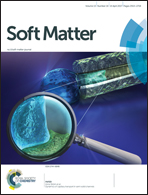Structural transformation of vesicles formed by a polystyrene-b-poly(acrylic acid)/polystyrene-b-poly(4-vinyl pyridine) mixture: from symmetric to asymmetric membranes†
Abstract
Asymmetric vesicles with different inner and outer corona compositions are applicable in microreactors, drug delivery, and biomimics because of their unique functions in membrane permeability and protein localization. In this study, we develop a novel approach to construct asymmetric vesicles and demonstrate the first structural transformation of polymeric vesicles from symmetric to asymmetric membranes. Experimental results and Monte Carlo simulation results clearly reveal that increased intercorona repulsion and enhanced hydrophobic chain mobility are essential to realize this transformation. Moreover, similar transformation processes are observed where either HCl or NaOH is added to change the intercorona interaction. This finding indicates that the observed structural transformation is dominated by physical interactions rather than chemical environment. The constructed asymmetric vesicles can be selectively decorated with gold nanoparticles on the outer corona. This study introduces a novel approach to prepare asymmetric vesicles and provides insights into the mechanism underlying the structural transformation of polymeric vesicles from symmetric to asymmetric membranes.



 Please wait while we load your content...
Please wait while we load your content...